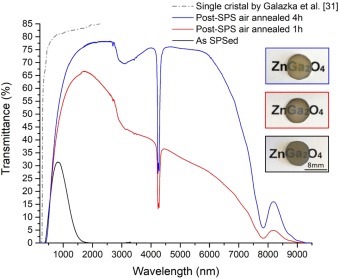Ask for a reprint
email :
* Give your email
2021
ACL
|
C.Mével, J.Carreaud, G.Delaizir, J.R.Duclère, F.Brisset, J.Bourret, P.Carles, C.Genevois, M.Allix, S.Chenu, 'First ZnGa2O4 transparent ceramics', J. Eur. Ceram. Soc. 41 4934-4941 (2021) doi:10.1016/j.jeurceramsoc.2021.03.038
Transparent polycrystalline ZnGa2O4 ceramics are synthesized, for the first time, by combining high-energy ball milling, solid-state reaction and spark plasma sintering. They appear transparent in both the visible and near infrared (up to 9 μm) ranges after a post-SPS annealing in air converting the raw semiconductor into an electrical insulator. The maximum of transmittance is reached in the near infrared region, at around 2.5 μm, with a value of 78 % (1 mm thick sample) close to the maximum value of transmittance previously measured for single crystals. These transparent ceramics present a classic cubic spinel ZnGa2O4 structure and a dense microstructure (> 99 %) attained without sintering aids, with an average grain size of 600 nm and a random orientation of the crystallites. TEM observations performed on thin foils have revealed limited nanometer scale intergranular porosity which does not affect much the transparency. As a proof of interest, red long-lasting luminescence arising from the entire sample volume is observed in these Cr3+ doped transparent ceramics. This innovative work is anticipated to further drive the development of transparent ZnGa2O4 ceramics towards a wider range of performing optical applications such as laser emission.
|

|